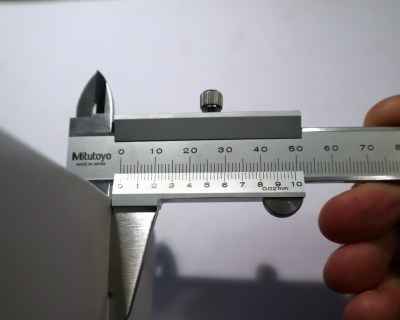I needed a temperature controller module recently, so off I went to Banggood to order one. As one does I found myself browsing, one thing led to another, and I bought a micrometer screw gauge. While micrometers are pretty expensive devices, reflecting their high precision engineering and construction, this micrometer cost me only about £8, or just under $10, definitely in the spirit of our long-running series of reviewing very cheap tools in search of a diamond in the rough. But perhaps more importantly, this is also the cue for an examination of high precision dimensional measurement. So I’ve assembled a collection of micrometers and vernier calipers of varying quality, and it’s time to dive in and measure some very small things.
Some of you will be metrology enthusiasts with an array of the finest devices available, but I am guessing that many of you will not. The ubiquitous precision measurement device in our community appears to be the digital caliper, a sliding clamp with an LCD display, an instrument that can be had in its most basic form for a very small outlay indeed. For the purposes of this piece though we’re not looking at digital devices but their analogue precursors. If you want a feel for metrology and you’d like some of those heritage tools that parents pass onto their kids then it’s time to learn something about the vernier caliper and the micrometer.
Traditional Metrology In A Digital Age
A Vernier caliper is a graduated sliding clamp usually over 150mm long, with a Vernier scale that allows the reading of fractions of its graduation. It will typically have two sets of jaws for both internal and external measurements, and an extending probe for depth measurements. On the body of the clamp are the millimetres or inches, and on the sliding jaw is a scale graduated in a constant fraction of the main scale. It’s a mathematical trick that allows the user to turn “ten and a bit millimetres” into “10.12 mm”, by working along the Vernier scale until one of the gradations lines up with a gradation on the main scale, and reading the fraction of a millimetre figure from the Vernier scale.
I have a friend with a background in a family business grinding tungsten carbide to a very high precision indeed who jokingly refers to a vernier caliper as “the guessing stick” because its precision is several factors of ten above her working zone, but the ability to add an extra digit and fraction of a digit’s precision to a millimetre reading depending on the Vernier scale in question over the whole relatively long range of the caliper makes it a very useful instrument indeed.
A micrometer is a G clamp with jaws in its most common form around 25 mm in size, and with a very accurately calibrated screw …read more
Source:: Hackaday

